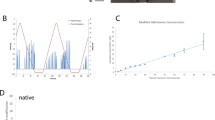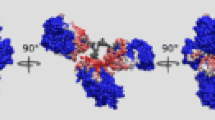Abstract
Unlike small molecule drugs, therapeutic proteins must maintain the proper higher-order structure (HOS) in order to maintain safety and efficacy. Due to the sensitivity of many protein systems, even small changes due to differences in protein expression or formulation can alter HOS. Previous work has demonstrated how hydroxyl radical protein footprinting (HRPF) can sensitively detect changes in protein HOS by measuring the average topography of the protein monomers, as well as identify specific regions of the therapeutic protein impacted by the conformational changes. However, HRPF is very sensitive to the radical scavenging capacity of the buffer; addition of organic buffers and/or excipients can dramatically alter the HRPF footprint without affecting protein HOS. By compensating for the radical scavenging effects of different adalimumab biosimilar formulations using real-time adenine dosimetry, we identify that sodium citrate buffer causes a modest decrease in average solvent accessibility compared to sodium phosphate buffer at the same pH. We find that the addition of polysorbate 80 does not alter the conformation of the biosimilar in either buffer, but it does provide substantial protection from protein conformational perturbation during short periods of exposure to high temperature. Compensated HRPF measurements are validated and contextualized by dynamic light scattering (DLS), which suggests that changes in adalimumab biosimilar aggregation are major drivers in measured changes in protein topography. Overall, compensated HRPF accurately measured conformational changes in adalimumab biosimilar that occurred during formulation changes and identified the effect of formulation changes on protection of HOS from temperature extremes.






Similar content being viewed by others
References
Global biopharmaceuticals market growth, trends and forecasts (2016–2021). In: Current trends in biopharmaceuticals market. Hyderabad, India: Mordor Intelligence; 2016.
Manning MC, Chou DK, Murphy BM, Payne RW, Katayama DS. Stability of protein pharmaceuticals: an update. Pharm Res. 2010;27(4):544–75. https://doi.org/10.1007/s11095-009-0045-6.
Giezen TJ, Mantel-Teeuwisse AK, Strauss S. Safety-related regulatory actions for biologicals approved in the United States and the European Union. J Am Med Soc. 2008;300(16):1887–96.
Giezen TJ, Schneider CK. Safety assessment of biosimilars in Europe: a regulatory perspective. Generics Biosimilars Initiat J. 2014;2014:1–8.
Buxton GV, Greenstock CL, Helman WP, Ross AB. Critical review of rate constants for reactions of hydrated electrons, hydrogen atoms and hydroxyl radicals (.OH/.O-) in aqueous solution. J Phys Chem Ref Data. 1988;17(2):513–886.
Xu G, Chance MR. Radiolytic modification and reactivity of amino acid residues serving as structural probes for protein footprinting. Anal Chem. 2005;77(14):4549–55.
Sharp JS, Tomer KB. Effects of anion proximity in peptide primary sequence on the rate and mechanism of leucine oxidation. Anal Chem. 2006;78(14):4885–93.
Xie B, Sood A, Woods RJ, Sharp JS. Quantitative protein topography measurements by high resolution hydroxyl radical protein footprinting enable accurate molecular model selection. Sci Rep. 2017;7(1):4552. https://doi.org/10.1038/s41598-017-04689-3.
Sharp JS, Becker JM, Hettich RL. Protein surface mapping by chemical oxidation: structural analysis by mass spectrometry. Anal Biochem. 2003;313(2):216–25.
Sharp JS, Becker JM, Hettich RL. Analysis of protein solvent accessible surfaces by photochemical oxidation and mass spectrometry. Anal Chem. 2004;76(3):672–83.
Chance MR. Unfolding of apomyoglobin examined by synchrotron footprinting. Biochem Biophys Res Commun. 2001;287(3):614–21.
Kiselar JG, Maleknia SD, Sullivan M, Downard KM, Chance MR. Hydroxyl radical probe of protein surfaces using synchrotron X-ray radiolysis and mass spectrometry. Int J Radiat Biol. 2002;78(2):101–14.
Huang W, Ravikumar KM, Chance MR, Yang S. Quantitative mapping of protein structure by hydroxyl radical footprinting-mediated structural mass spectrometry: a protection factor analysis. Biophys J. 2015;108(1):107–15. https://doi.org/10.1016/j.bpj.2014.11.013.
Charvatova O, Foley BL, Bern MW, Sharp JS, Orlando R, Woods RJ. Quantifying protein interface footprinting by hydroxyl radical oxidation and molecular dynamics simulation: application to galectin-1. J Am Soc Mass Spectrom. 2008;19(11):1692–705.
Maleknia SD, Chance MR, Downard KM. Electrospray-assisted modification of proteins: a radical probe of protein structure. Rapid Commun Mass Spectrom. 1999;13(23):2352–8.
Goldsmith SC, Guan JQ, Almo S, Chance M. Synchrotron protein footprinting: a technique to investigate protein-protein interactions. J Biomol Struct Dyn. 2001;19(3):405–18.
McClintock C, Kertesz V, Hettich RL. Development of an electrochemical oxidation method for probing higher order protein structure with mass spectrometry. Anal Chem. 2008;80(9):3304–17.
Watson C, Janik I, Zhuang T, Charvatova O, Woods RJ, Sharp JS. Pulsed electron beam water radiolysis for submicrosecond hydroxyl radical protein footprinting. Anal Chem. 2009;81(7):2496–505.
Hambly DM, Gross ML. Laser flash photolysis of hydrogen peroxide to oxidize protein solvent-accessible residues on the microsecond timescale. J Am Soc Mass Spectrom. 2005;16(12):2057–63.
Aye TT, Low TY, Sze SK. Nanosecond laser-induced photochemical oxidation method for protein surface mapping with mass spectrometry. Anal Chem. 2005;77(18):5814–22.
Gau BC, Sharp JS, Rempel DL, Gross ML. Fast photochemical oxidation of protein footprints faster than protein unfolding. Anal Chem. 2009;81(16):6563–71. https://doi.org/10.1021/ac901054w.
Watson C, Sharp JS. Conformational analysis of therapeutic proteins by hydroxyl radical protein footprinting. AAPS J. 2012;14(2):206–17. https://doi.org/10.1208/s12248-012-9336-7.
Lin M, Krawitz D, Callahan MD, Deperalta G, Wecksler AT. Characterization of ELISA antibody-antigen interaction using footprinting-mass spectrometry and negative staining transmission electron microscopy. J Am Soc Mass Spectrom. 2018;29(5):961–71. https://doi.org/10.1007/s13361-017-1883-9.
Storek KM, Auerbach MR, Shi H, Garcia NK, Sun D, Nickerson NN, et al. Monoclonal antibody targeting the beta-barrel assembly machine of Escherichia coli is bactericidal. Proc Natl Acad Sci U S A. 2018;115(14):3692–7. https://doi.org/10.1073/pnas.1800043115.
Zhang Y, Wecksler AT, Molina P, Deperalta G, Gross ML. Mapping the binding interface of VEGF and a monoclonal antibody Fab-1 fragment with fast photochemical oxidation of proteins (FPOP) and mass spectrometry. J Am Soc Mass Spectrom. 2017;28(5):850–8. https://doi.org/10.1007/s13361-017-1601-7.
Li J, Wei H, Krystek SR Jr, Bond D, Brender TM, Cohen D, et al. Mapping the energetic epitope of an antibody/interleukin-23 interaction with hydrogen/deuterium exchange, fast photochemical oxidation of proteins mass spectrometry, and alanine shave mutagenesis. Anal Chem. 2017;89(4):2250–8. https://doi.org/10.1021/acs.analchem.6b03058.
Sharp JS, Misra SK, Persoff JJ, Egan RW, Weinberger SR. Real time normalization of fast photochemical oxidation of proteins experiments by inline adenine radical dosimetry. Anal Chem. 2018;90(21):12625–30. https://doi.org/10.1021/acs.analchem.8b02787.
Li Z, Moniz H, Wang S, Ramiah A, Zhang F, Moremen KW, et al. High structural resolution hydroxyl radical protein footprinting reveals an extended robo1-heparin binding interface. J Biol Chem. 2015;290(17):10729–40. https://doi.org/10.1074/jbc.M115.648410.
Niu B, Mackness BC, Rempel DL, Zhang H, Cui W, Matthews CR, et al. Incorporation of a reporter peptide in FPOP compensates for adventitious scavengers and permits time-dependent measurements. J Am Soc Mass Spectrom. 2017;28(2):389–92. https://doi.org/10.1007/s13361-016-1552-4.
Niu B, Zhang H, Giblin D, Rempel DL, Gross ML. Dosimetry determines the initial OH radical concentration in fast photochemical oxidation of proteins (FPOP). J Am Soc Mass Spectrom. 2015;26(5):843–6. https://doi.org/10.1007/s13361-015-1087-0.
Xie B, Sharp JS. Hydroxyl radical dosimetry for high flux hydroxyl radical protein footprinting applications using a simple optical detection method. Anal Chem. 2015;87(21):10719–23. https://doi.org/10.1021/acs.analchem.5b02865.
Riaz M, Misra SK, Sharp JS. Towards high-throughput fast photochemical oxidation of proteins: quantifying exposure in high fluence microtiter plate photolysis. Anal Biochem. 2018;561-562:32–6. https://doi.org/10.1016/j.ab.2018.09.014.
Konermann L, Stocks BB, Czarny T. Laminar flow effects during laser-induced oxidative labeling for protein structural studies by mass spectrometry. Anal Chem. 2010;82(15):6667–74. https://doi.org/10.1021/Ac101326f.
Xu G, Chance MR. Hydroxyl radical-mediated modification of proteins as probes for structural proteomics. Chem Rev. 2007;107(8):3514–43.
Singh SM, Bandi S, Jones DNM, Mallela KMG. Effect of polysorbate 20 and polysorbate 80 on the higher-order structure of a monoclonal antibody and its Fab and Fc fragments probed using 2D nuclear magnetic resonance spectroscopy. J Pharm Sci. 2017;106(12):3486–98. https://doi.org/10.1016/j.xphs.2017.08.011.
Kaur P, Kiselar J, Yang S, Chance MR. Quantitative protein topography analysis and high-resolution structure prediction using hydroxyl radical labeling and tandem-ion mass spectrometry (MS). Mol Cell Proteomics. 2015;14(4):1159–68. https://doi.org/10.1074/mcp.O114.044362.
Smedley JG, Sharp JS, Kuhn JF, Tomer KB. Probing the pH-dependent prepore to pore transition of Bacillus anthracis protective antigen with differential oxidative protein footprinting. Biochemistry. 2008;47(40):10694–704.
Acknowledgments
J.S.S., R.O., and S.R.W. acknowledge support of the National Institute of General Medical Sciences (R43GM125420) to support commercial development of a benchtop FPOP device. J.S.S. and S.K.M. acknowledge support from the National Institute of General Medical Sciences for the development of compensation protocols for high radical scavenging environments (R01GM127267).
Author information
Authors and Affiliations
Corresponding author
Ethics declarations
Financial Conflict of Interest Disclosure
J.S.S., R.O., and S.R.W. disclose a significant financial interest in GenNext Technologies, Inc., an early-stage company seeking to commercialize technologies for protein higher-order structure analysis. This manuscript and all data were reviewed by S.K.M., who has no financial conflict of interest, in accordance with the University of Mississippi FCOI management practices.
Additional information
Publisher’s Note
Springer Nature remains neutral with regard to jurisdictional claims in published maps and institutional affiliations.
Electronic supplementary material
ESM 1
(DOCX 946 kb)
Rights and permissions
About this article
Cite this article
Misra, S.K., Orlando, R., Weinberger, S.R. et al. Compensated Hydroxyl Radical Protein Footprinting Measures Buffer and Excipient Effects on Conformation and Aggregation in an Adalimumab Biosimilar. AAPS J 21, 87 (2019). https://doi.org/10.1208/s12248-019-0358-2
Received:
Accepted:
Published:
DOI: https://doi.org/10.1208/s12248-019-0358-2




